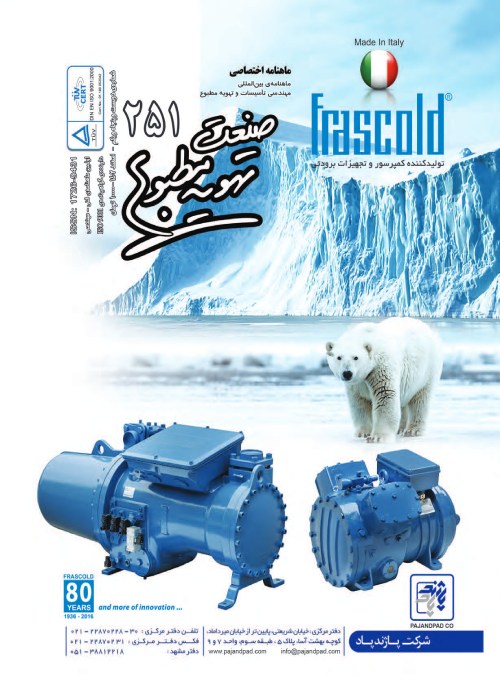فهرست مطالب
ماهنامه تهویه مطبوع
پیاپی 53 (شهریور 1386)
- تاریخ انتشار: 1386/06/20
- تعداد عناوین: 20
-
صفحه 3The availability of multimodal imaging techniques enables the acquisition of both structural and functional information of the brain, and it opens a unique window for revealing the brain activity and connectivity in neuro-psychiatric disorders. The current lecture will review some of the most often used imaging modalities, with particular emphasis on MRI, in the research field of major neuro-psychiatric disorders from the functional perspective. Diffused tension image shows the white matter in vivo and provides us with useful parameters such as FA and ADC to assess the brain tissue integrity. Perfusion MRI helps to assess the cerebral blood flow relevant to functional alteration. BOLD fMRI is readily available for the functional brain assessment in psychiatry with task and non-task design (i.e. resting-state fMRI). The topic of fMRI will be focused, and in particular, the resting-state fMRI which has recently attracted considerable attentions and has shown potentials in future clinical applications. The current lecture will specifically focuse on the recent advances of MR imaging research in epilepsy, schizophrenia and major depressive disorders.
-
صفحه 4Neoplastic invasion of the laryngeal cartilage is a major determinant for clinical staging, treatment planning and prognosis of laryngeal and hypopharyngeal neoplasms. In fact, cartilage involvement is one of the determinants which necessitate total laryngectomy. Computed tomography scan (CT scan) could be used for detecting the involvement.
Laryngeal cartilages are seen in two different histological patterns: nonossified and ossified. This fact causes different attenuation values of laryngeal cartilages in CT scan images. The neoplastic invasion could result in pathological cartilage ossification. Presence of cortex and medullary cavity implies a physiological ossification process, whereas a pathological process presents as cortical thickening and/or partial or complete loss of cortico-medullary differentiation.
However, most arytenoid and some of the thyroid cartilages could physiologically present as cortical thickening and/or absence of cortico-medullary differentiation which in turn reduces the specificity (0.38-0.73) of this finding.
Considering these points, sclerosis would be a relatively sensitive CT finding of neoplastic cartilage invasion (0.59-0.81) which the highest value is seen in the thyroid cartilage.
Regarding chondrolysis and erosion the high specificities (0.91-0.98) for different laryngeal cartilages are seen which could be due to the fact that erosion is caused by direct invasion and it is not an inflammatory response. This fact makes the cartilage erosion a suitable marker for treatment planning.
Physiological ossification of the thyroid cartilage may be mistaken with lysis due to neoplasm. Therefore, arytenoid cartilage erosion has higher specificity for neoplastic invasion.
In conclusion, cartilage sclerosis in CT images is the most sensitive finding and cartilage erosion is the most specific finding for the diagnosis of laryngeal cartilage neoplastic invasion. If we combine both of these findings for an individual laryngeal cartilage, we can consider neoplastic invasion with high specificity in the case of cricoid or arytenoid cartilage -
صفحه 10
-
صفحه 13The basic concept of hemodialysis access is to make a route to the central circulation in CRF patients. Vascular access procedures and subsequent complications represent a major cause of morbidity, hospitalization and cost for hemodialysis patients. Native arteriovenous fistulas (AVFs) are preferable to synthetic arteriovenous grafts because they are associated with a lower frequency of thrombosis and infection, as well as greater longevity. AVFs that are never usable and early graft failures are associated with the common problem of inadequate vessel (artery or vein) selection. The surgeon’s preoperative physical examination is the primary basis for AVF versus graft selection. Only palpable veins are considered for construction of AVFs, and the more proximal draining venous anatomy is not known prior to the operation. Physical examination is the traditional surgical evaluation performed prior to hemodialysis access placement. Palpation and inspection are difficult in obese arms, and few patients have vessels that are visible throughout their entire course. Patients with end-stage renal disease have often had multiple venipunctures and numerous intravenous lines placed and thus have an increased likelihood of venous stenosis or occlusion. Central vein problems are difficult to detect at visual inspection. By colour Doppler analysis vessels can be assessed for size, stenosis, and occlusion. US mapping assists in surgical planning and is especially valuable in patients who are difficult surgical cases (eg, obesity, diabetes, history of prior access, elderly women).
This lecture contains two separate sections: 1-Vascular mapping prior to access placement and 2-Fistula maturity by US evaluation. Ultrasonography (US) is an excellent modality for hemodialysis access evaluation because it is readily available, non-invasive and inexpensive. It avoids the risks associated with iodinated contrast material and ionizing radiation.
-
صفحه 14Dizziness that patients complain from are rotational vertigo, sense of instability, ataxia of gait, disturbance of vision, loss of contact with surroundings, nausea, loss of memory, loss of confidence, epileptic convulsion and dizziness that is considered by medical staff are:1- Vertigo as a sense of feeling the environment moving when it does not persist in all positions, aggravated by head movement.
2- Disequilibrium as a feeling of unsteadiness or insecurity without rotation, standing and walking are difficult.
3- Light headedness as swimming, floating, giddy or swaying sensation in the head or in the room.
-
صفحه 19
-
صفحه 22
-
صفحه 24
-
صفحه 27
-
صفحه 28
-
صفحه 32
-
صفحه 38
-
صفحه 46
-
صفحه 47


